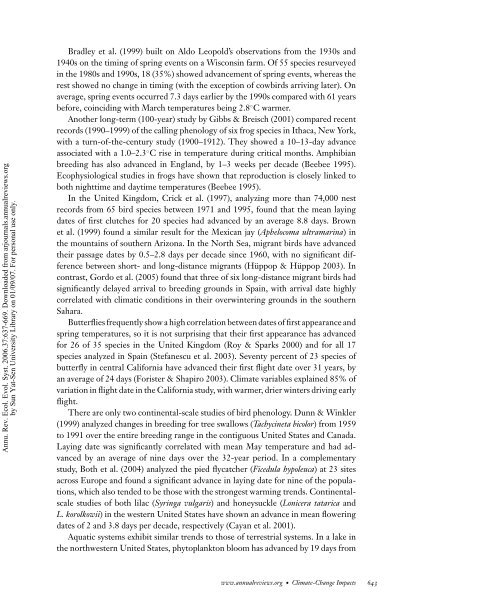Ecological and Evolutionary Responses to Recent Climate Change
Ecological and Evolutionary Responses to Recent Climate Change
Ecological and Evolutionary Responses to Recent Climate Change
Create successful ePaper yourself
Turn your PDF publications into a flip-book with our unique Google optimized e-Paper software.
Annu. Rev. Ecol. Evol. Syst. 2006.37:637-669. Downloaded from arjournals.annualreviews.org<br />
by Sun Yat-Sen University Library on 01/09/07. For personal use only.<br />
Bradley et al. (1999) built on Aldo Leopold’s observations from the 1930s <strong>and</strong><br />
1940s on the timing of spring events on a Wisconsin farm. Of 55 species resurveyed<br />
in the 1980s <strong>and</strong> 1990s, 18 (35%) showed advancement of spring events, whereas the<br />
rest showed no change in timing (with the exception of cowbirds arriving later). On<br />
average, spring events occurred 7.3 days earlier by the 1990s compared with 61 years<br />
before, coinciding with March temperatures being 2.8 ◦ C warmer.<br />
Another long-term (100-year) study by Gibbs & Breisch (2001) compared recent<br />
records (1990–1999) of the calling phenology of six frog species in Ithaca, New York,<br />
with a turn-of-the-century study (1900–1912). They showed a 10–13-day advance<br />
associated with a 1.0–2.3 ◦ C rise in temperature during critical months. Amphibian<br />
breeding has also advanced in Engl<strong>and</strong>, by 1–3 weeks per decade (Beebee 1995).<br />
Ecophysiological studies in frogs have shown that reproduction is closely linked <strong>to</strong><br />
both nighttime <strong>and</strong> daytime temperatures (Beebee 1995).<br />
In the United Kingdom, Crick et al. (1997), analyzing more than 74,000 nest<br />
records from 65 bird species between 1971 <strong>and</strong> 1995, found that the mean laying<br />
dates of first clutches for 20 species had advanced by an average 8.8 days. Brown<br />
et al. (1999) found a similar result for the Mexican jay (Aphelocoma ultramarina) in<br />
the mountains of southern Arizona. In the North Sea, migrant birds have advanced<br />
their passage dates by 0.5–2.8 days per decade since 1960, with no significant difference<br />
between short- <strong>and</strong> long-distance migrants (Hüppop & Hüppop 2003). In<br />
contrast, Gordo et al. (2005) found that three of six long-distance migrant birds had<br />
significantly delayed arrival <strong>to</strong> breeding grounds in Spain, with arrival date highly<br />
correlated with climatic conditions in their overwintering grounds in the southern<br />
Sahara.<br />
Butterflies frequently show a high correlation between dates of first appearance <strong>and</strong><br />
spring temperatures, so it is not surprising that their first appearance has advanced<br />
for 26 of 35 species in the United Kingdom (Roy & Sparks 2000) <strong>and</strong> for all 17<br />
species analyzed in Spain (Stefanescu et al. 2003). Seventy percent of 23 species of<br />
butterfly in central California have advanced their first flight date over 31 years, by<br />
an average of 24 days (Forister & Shapiro 2003). <strong>Climate</strong> variables explained 85% of<br />
variation in flight date in the California study, with warmer, drier winters driving early<br />
flight.<br />
There are only two continental-scale studies of bird phenology. Dunn & Winkler<br />
(1999) analyzed changes in breeding for tree swallows (Tachycineta bicolor) from 1959<br />
<strong>to</strong> 1991 over the entire breeding range in the contiguous United States <strong>and</strong> Canada.<br />
Laying date was significantly correlated with mean May temperature <strong>and</strong> had advanced<br />
by an average of nine days over the 32-year period. In a complementary<br />
study, Both et al. (2004) analyzed the pied flycatcher (Ficedula hypoleuca) at 23 sites<br />
across Europe <strong>and</strong> found a significant advance in laying date for nine of the populations,<br />
which also tended <strong>to</strong> be those with the strongest warming trends. Continentalscale<br />
studies of both lilac (Syringa vulgaris) <strong>and</strong> honeysuckle (Lonicera tatarica <strong>and</strong><br />
L. korolkowii) in the western United States have shown an advance in mean flowering<br />
dates of 2 <strong>and</strong> 3.8 days per decade, respectively (Cayan et al. 2001).<br />
Aquatic systems exhibit similar trends <strong>to</strong> those of terrestrial systems. In a lake in<br />
the northwestern United States, phy<strong>to</strong>plank<strong>to</strong>n bloom has advanced by 19 days from<br />
www.annualreviews.org • <strong>Climate</strong>-<strong>Change</strong> Impacts 643
















